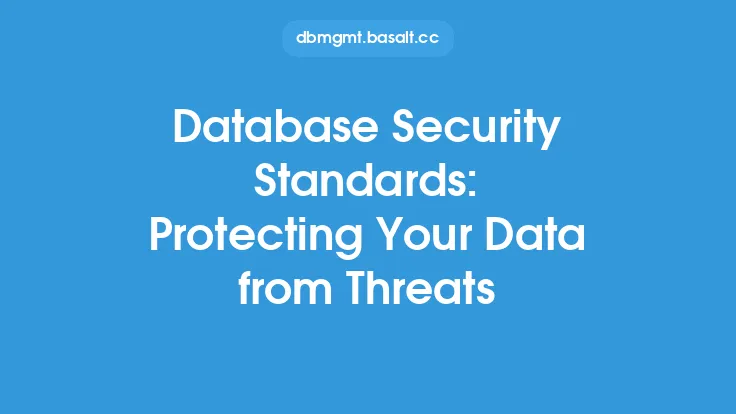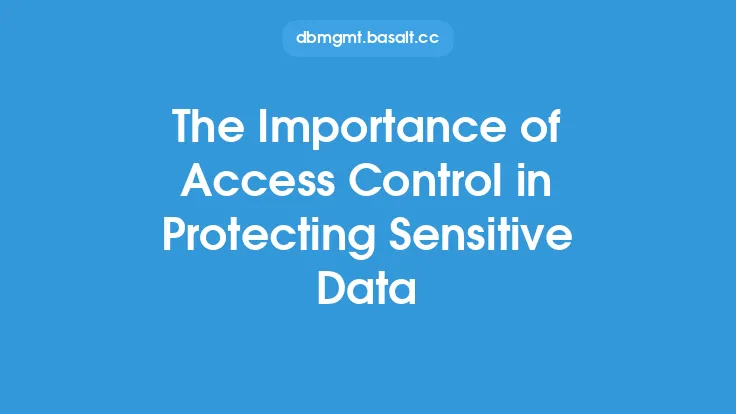Data integration is a critical process in database implementation, as it enables organizations to combine data from multiple sources into a unified view, facilitating informed decision-making and improved business outcomes. However, this process also introduces security risks, as sensitive data is being accessed, processed, and stored. Therefore, it is essential to implement robust security measures to protect sensitive data during the data integration process.
Introduction to Data Integration Security
Data integration security refers to the practices, policies, and technologies used to protect sensitive data during the data integration process. This includes ensuring the confidentiality, integrity, and availability of data, as well as complying with relevant regulations and standards. Data integration security is a critical aspect of database implementation, as it helps to prevent data breaches, unauthorized access, and other security threats.
Threats to Data Integration Security
There are several threats to data integration security, including unauthorized access, data breaches, malware, and denial-of-service (DoS) attacks. Unauthorized access occurs when an individual or entity gains access to sensitive data without permission, while data breaches involve the unauthorized disclosure of sensitive data. Malware, such as viruses and Trojan horses, can compromise data integration systems, while DoS attacks can overwhelm systems, making them unavailable. Additionally, insider threats, such as employees or contractors with authorized access, can also pose a significant risk to data integration security.
Security Measures for Data Integration
To protect sensitive data during the data integration process, several security measures can be implemented. These include data encryption, access controls, authentication, and auditing. Data encryption involves converting sensitive data into an unreadable format, making it inaccessible to unauthorized individuals. Access controls, such as role-based access control (RBAC), can limit access to sensitive data based on user roles and permissions. Authentication mechanisms, such as username and password combinations, can verify the identity of users, while auditing can track and monitor data access and modifications.
Data Encryption Techniques
Data encryption is a critical security measure for protecting sensitive data during the data integration process. There are several data encryption techniques, including symmetric key encryption, asymmetric key encryption, and hash functions. Symmetric key encryption uses the same key for encryption and decryption, while asymmetric key encryption uses a pair of keys, one for encryption and another for decryption. Hash functions, such as SHA-256, can create a digital fingerprint of data, making it possible to detect any modifications or tampering.
Access Control Mechanisms
Access control mechanisms are essential for limiting access to sensitive data during the data integration process. RBAC is a popular access control mechanism, as it assigns access permissions based on user roles and responsibilities. Additionally, attribute-based access control (ABAC) can grant access based on user attributes, such as department or job function. Mandatory access control (MAC) can enforce access controls based on a set of rules, while discretionary access control (DAC) can grant access based on user identity and permissions.
Authentication and Authorization
Authentication and authorization are critical security measures for protecting sensitive data during the data integration process. Authentication mechanisms, such as username and password combinations, can verify the identity of users, while authorization mechanisms, such as access control lists (ACLs), can grant access to sensitive data based on user permissions. Additionally, multi-factor authentication (MFA) can provide an additional layer of security, requiring users to provide multiple forms of verification, such as a password and a fingerprint.
Auditing and Monitoring
Auditing and monitoring are essential for tracking and detecting security threats during the data integration process. Auditing can track data access and modifications, while monitoring can detect unusual activity, such as multiple failed login attempts. Additionally, logging can record system events, making it possible to investigate security incidents and identify the root cause.
Compliance and Regulatory Requirements
Data integration security must comply with relevant regulations and standards, such as the General Data Protection Regulation (GDPR), the Health Insurance Portability and Accountability Act (HIPAA), and the Payment Card Industry Data Security Standard (PCI DSS). These regulations and standards require organizations to implement robust security measures, such as data encryption, access controls, and auditing, to protect sensitive data.
Best Practices for Data Integration Security
To ensure the security of sensitive data during the data integration process, several best practices can be followed. These include implementing robust security measures, such as data encryption and access controls, regularly updating and patching systems, and providing security awareness training to employees and contractors. Additionally, conducting regular security audits and risk assessments can help identify vulnerabilities and weaknesses, while implementing incident response plans can ensure a rapid response to security incidents.
Conclusion
Data integration security is a critical aspect of database implementation, as it helps to protect sensitive data during the data integration process. By implementing robust security measures, such as data encryption, access controls, authentication, and auditing, organizations can ensure the confidentiality, integrity, and availability of sensitive data. Additionally, complying with relevant regulations and standards, and following best practices, such as regularly updating and patching systems, and providing security awareness training, can help prevent security threats and ensure the security of sensitive data.





